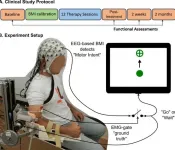(Press-News.org) Almost 18,000 Americans experience traumatic spinal cord injuries every year. Many of these people are unable to use their hands and arms and can't do everyday tasks such as eating, grooming or drinking water without help.
Using physical therapy combined with a noninvasive method of stimulating nerve cells in the spinal cord, University of Washington researchers helped six Seattle area participants regain some hand and arm mobility. That increased mobility lasted at least three to six months after treatment had ended. The research team published these findings Jan. 5 in the journal IEEE Transactions on Neural Systems and Rehabilitation Engineering.
"We use our hands for everything -- eating, brushing our teeth, buttoning a shirt. Spinal cord injury patients rate regaining hand function as the absolute first priority for treatment. It is five to six times more important than anything else that they ask for help on," said lead author Dr. Fatma Inanici, a UW senior postdoctoral researcher in electrical and computer engineering who completed this research as a doctoral student of rehabilitation medicine in the UW School of Medicine.
"At the beginning of our study," Inanici said, "I didn't expect such an immediate response starting from the very first stimulation session. As a rehabilitation physician, my experience was that there was always a limit to how much people would recover. But now it looks like that's changing. It's so rewarding to see these results."
After a spinal cord injury, many patients do physical therapy to help them attempt to regain mobility. Recently, a series of studies have shown that implanting a stimulator to deliver electric current to a damaged spinal cord could help paralyzed patients walk again.
The UW team, composed of researchers from the Center for Neurotechnology, combined stimulation with standard physical therapy exercises, but the stimulation doesn't require surgery. Instead, it involves small patches that stick to a participant's skin like a Band-Aid. These patches are placed around the injured area on the back of the neck where they deliver electrical pulses.
The researchers recruited six people with chronic spinal cord injuries. All participants had been injured for at least a year and a half. Some participants couldn't wiggle their fingers or thumbs while others had some mobility at the beginning of the study.
To explore the viability of using the skin-surface stimulation method, the researchers designed a five-month training program. For the first month, the researchers monitored participants' baseline limb movements each week. Then for the second month, the team put participants through intensive physical therapy training, three times a week for two hours at a time. For the third month, participants continued physical therapy training but with stimulation added.
"We turned on the device, but they continued doing the exact same exercises they did the previous month, progressing to slightly more difficult versions if they improved," Inanici said.
For the last two months of the study, participants were divided into two categories: Participants with less severe injuries received another month of training alone and then a month of training plus stimulation. Patients with more severe injuries received the opposite -- training and stimulation first, followed by only training second.
While some participants regained some hand function during training alone, all six saw improvements when stimulation was combined with training.
"Both people who had no hand movement at the beginning of the study started moving their hands again during stimulation, and were able to produce a measurable force between their fingers and thumb," said senior author Chet Moritz, a UW associate professor of electrical and computer engineering, rehabilitation medicine and physiology and biophysics. "That's a dramatic change, to go from being completely paralyzed below the wrists down to moving your hands at will."
In addition, some participants noticed other improvements, including a more normal heart rate and better regulation of body temperature and bladder function.
The team followed up with participants for up to six months after training and found that these improvements remained, despite no more stimulation.
"We think these stimulators bring the nerves that make your muscles contract very close to being active. They don't actually cause the muscle to move, but they get it ready to move. It's primed, like the sprinter at the start of a race," said Moritz, who is also the co-director of the Center for Neurotechnology. "Then when someone with a spinal cord injury wants to move, the few connections that might have been spared around the injury are enough to cause those muscles to contract."
The research is moving toward helping people in the clinic. The results of this study have already informed the design of an international multi-site clinical trial that will be co-led by Moritz. One of the lead sites will be at the UW.
"We're seeing a common theme across universities -- stimulating the spinal cord electrically is making people better," Moritz said. "But it does take motivation. The stimulator helps you do the exercises, and the exercises help you get stronger, but the improvements are incremental. Over time, however, they add up into something that's really astounding."
INFORMATION:
Lorie Brighton, a research scientist at the UW; Soshi Samejima, a UW doctoral student in rehabilitation medicine; and Dr. Christoph Hofstetter, an associate professor of neurological surgery in the UW School of Medicine, are co-authors on this paper. This research was funded by the Center for Neurotechnology, the Washington State Spinal Cord Injury Consortium and the Christopher and Dana Reeve Foundation.
For more information, contact Inanici at finanici@uw.edu and Moritz at ctmoritz@uw.edu.
Grant number: EEC-1028725
A recent study finds that, in the wake of a mass shooting, National Rifle Association (NRA) employees, donors and volunteers had extremely mixed emotions about the organization - reporting higher levels of both positive and negative feelings about the NRA, as compared to people with no NRA affiliation.
"We wanted to see what effect 'in-group' affiliation and political identity had on how people responded to the NRA's actions after a mass shooting," says Yang Cheng, co-author of the study and an assistant professor of communication at North Carolina State University. "The political findings were predictable - Republicans thought more favorably of the NRA than Democrats did. But the in-group affiliation was a lot more complex than ...
Stroke survivors who had ceased to benefit from conventional rehabilitation gained clinically significant arm movement and control by using an external robotic device powered by the patients' own brains.
The results of the clinical trial were described in the journal NeuroImage: Clinical.
Jose Luis Contreras-Vidal, director of the Non-Invasive Brain Machine Interface Systems Laboratory at the University of Houston, said testing showed most patients retained the benefits for at least two months after the therapy sessions ended, suggesting the potential for long-lasting gains. He is also Hugh Roy and Lillie Cranz Cullen Distinguished Professor of electrical and computer engineering.
The trial involved training stroke survivors with limited movement in one arm to use a brain-machine interface ...
GAINESVILLE, Fla. --- Entomologist Akito Kawahara's message is straightforward: We can't live without insects. They're in trouble. And there's something all of us can do to help.
Kawahara's research has primarily focused on answering fundamental questions about moth and butterfly evolution. But he's increasingly haunted by studies that sound the alarm about plummeting insect numbers and diversity.
Kawahara has witnessed the loss himself. As a child, he collected insects with his father every weekend, often traveling to a famous oak outside Tokyo ...
MANHATTAN, KANSAS -- Kyle Goerl, the medical director of Kansas State University's Lafene Health Center, is part of a collaborative team that is providing research-based guidance during the COVID-19 pandemic. The team's latest research contributed to the updated quarantine guidance from the Centers for Disease Control and Prevention.
Goerl is a co-author of the publication "Time from Start of Quarantine to SARS-CoV-2 Positive Test Among Quarantined College and University Athletes." The publication appeared in the Morbidity and Mortality Weekly Report from the CDC on Friday, Jan. 8, and involved researchers from multiple organizations and universities.
The publication was one of many that the ...
Osaka, Japan -- Ultra-intense lasers with ultra-short pulses and ultra-high energies are powerful tools for exploring unknowns in physics, cosmology, material science, etc. With the help of the famous technology "Chirped Pulse Amplification (CPA)" (2018 Nobel Prize in Physics), the current record has reached 10 Petawatts (or 10^16 Watts). In a study recently published in Scientific Reports, researchers from Osaka University proposed a concept for next-generation ultra-intense lasers with a simulated peak power up to the Exawatt class (1 Exawatt equals 1000 Petawatts).
The laser, which was invented by Dr. T. H. Maiman in 1960, has one important characteristic of high intensity (or high peak power for pulse lasers): historically, laser peak ...
Scientists at Nanyang Technological University, Singapore (NTU Singapore) have developed insulin nanoparticles that may one day become the basis for an oral medicine, and an alternative to insulin injections for diabetic patients.
In a pre-clinical study, the NTU Singapore team fed insulin-containing nanoparticles to rats and found that insulin increased in their blood minutes later.
Insulin therapy is often an important part of treatment for diabetes, a metabolic disease that affects 422 million people globally . In Singapore, the number of diabetics is expected to grow to 1 million - almost a fifth of the population - in 2050 .
Delivering insulin orally would be preferable over insulin jabs for patients because it causes less ...
Anthropogenic, or human-made, heat flux in the near-surface atmosphere has changed urban thermal environments. Much of this fluctuation has been noted with rapid development of the global economy and urbanization since the turn of the 21st century. Meanwhile, the number of extreme temperature events in the first decade of the 21st century grew faster than in the last 10 years of the 20th century. During this period, urban extreme heat events have become more frequent, breaking temperature records more often.
"We found the relationships between anthropogenic heat flux and extreme temperature events..." said Prof. Zhenghui Xie, a scientist with the Institute of Atmospheric Physics, Chinese Academy of Sciences. "...including ...
DALLAS - Jan. 12, 2021 - A team of UT Southwestern researchers has identified a gene involved in the growth of breast cancer, a finding that could lead to potential new targets for treatment.
"The gene ZMYND8 is increased in breast cancer conditions, and higher levels of the gene correlate with poor survival of breast cancer patients," says Yingfei Wang, Ph.D., assistant professor of pathology and neurology and corresponding author of the new study, published in Cancer Research. "It could be a promising target for antitumor immunotherapy."
In the U.S., about 1 in 8 women will develop breast cancer at some point in their life. Worldwide, breast cancer is the most common cancer ...
In a paper published in Molecular Frontiers Journal, researchers from Cambridge, Massachusetts and Bangalore, India study the effectiveness of FEND product to significantly improve airway hygiene by reducing and suppressing respiratory droplets potentially containing airborne pathogens and other contaminants. The study's findings further highlight why the FEND product is an important new daily hygiene protocol that joins century-old hand washing, masking and distancing measures as a fourth protective layer of defense against aerosolized particles.
The new study examined two nasal salines: ...
CORVALLIS, Ore. - A resemblance to moss, lichens and fungi made for fantastic cover by a new genus and species of cylindrical bark beetle described by an Oregon State University College of Science researcher.
"If you can't beat your enemies or run away, then hide, and that is what this Cretaceous beetle is doing," said OSU's George Poinar Jr. "He is hiding under a spectacular camouflage of his own making, allowing him to blend into a mossy background."
Poinar, an international expert in using plant and animal life forms preserved in amber to learn more about the biology and ecology of the distant past, and collaborator Fernando ...







